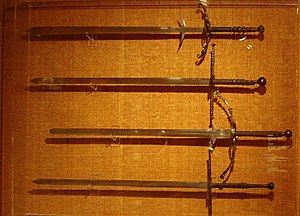| Zweihänder | |
|---|---|
 Zweihänders with and without Parierhaken | |
| Type | Sword |
| Service history | |
| In service | ca. 1500-1550 |
| Specifications | |
| Mass | 2 - 3.2 kg |
| Length | up to 180 cm |
|
| |
| Blade type | Double-edged, straight bladed |
| Hilt type | Two-handed cruciform, with pommel |
The ![]() Zweihänder (help·info) (German for "two-hander", also called Great sword, Bidenhänder, Schlachtschwerter[1] or Bihänder), is a two-handed sword primarily of the Renaissance. It is a true two-handed sword because it requires two hands to wield it. This is in comparison with other large swords that can be used with two hands, but also can be used with one.[2]
The Zweihänder swords develop seamlessly out of the German "Langschwert" (longsword) of the Late Middle Ages, and they became a hallmark weapon of the German Landsknechte from the time of Maximilian I (d. 1519) and during the Italian Wars of 1494–1559. The Goliath Fechtbuch (1510) shows an intermediate form between longsword and Zweihänder
Zweihänder (help·info) (German for "two-hander", also called Great sword, Bidenhänder, Schlachtschwerter[1] or Bihänder), is a two-handed sword primarily of the Renaissance. It is a true two-handed sword because it requires two hands to wield it. This is in comparison with other large swords that can be used with two hands, but also can be used with one.[2]
The Zweihänder swords develop seamlessly out of the German "Langschwert" (longsword) of the Late Middle Ages, and they became a hallmark weapon of the German Landsknechte from the time of Maximilian I (d. 1519) and during the Italian Wars of 1494–1559. The Goliath Fechtbuch (1510) shows an intermediate form between longsword and Zweihänder
These swords represent the final stage in the trend of increasing size started in the 14th century. In its developed form, the Zweihänder has acquired the characteristics of a polearm rather than a sword. Consequently, it is not carried in a sheath, but across the shoulder like a halberd. By the second half of the 16th century, these swords had largely ceased to have a practical application, but they continued to see ceremonial or representative use well into the 17th century. Some ceremonial zweihänder, called "bearing-swords" or "parade-swords" (Paratschwert), were much larger, weighing about 10 pounds.[3]
Morphology[]
Due to their size and weight — typically at least 1.4 m (4 ft 71⁄8 in) long and with a weight of over 2 kg — Zweihänders require two hands; as such they require at least 25 cm (9.84 in) for the grip.[4] Zweihänders above 4 kg are considered to be more ceremonial than practical.
Early Zweihänders were simply larger versions of hand and a half swords. Later examples had Parierhaken ("parrying hooks") at the top of the ricasso as well as side rings on the hilt. A sword did not necessarily have both features.[5]
Some Zweihänders had wavy blades and were called Flammenschwert.
Application[]

1548 depiction of a Zweihänder used against pikes in the Battle of Kappel
The weapon is mostly associated with either Swiss or German mercenaries known as Landsknecht, and their wielders were Doppelsöldner. However, the Swiss outlawed their use, while the Landsknecht kept using them until much later.[6] The Black Band of German mercenaries (active during the 1510s and 1520s) included 2,000 two-handed swordsmen in a total strength of 17,000 men. Zweihänder wielders fought with and against pike formations. There are some accounts of Zweihänders cutting off pike heads. Zweihänders were also used for guarding bridges or certain routs, because of the large circular movements that using them are often associated with have high area of control and denial. Soldiers trained in the use of the sword were granted the title of Meister des langen Schwertes (lit. Master of the Long Sword) by the Marx brotherhood.
Frisian hero Pier Gerlofs Donia is reputed to have wielded a Zweihänder with such skill, strength and efficiency that he managed to behead several people with it in a single blow. The Zweihänder ascribed to him is, as of 2008, on display in the Frisian museum. It has a length of 213 cm (84 in) and a weight of about 6.6 kg (141⁄2 lb).[7]
References[]
- ↑ Oakeshott, Ewart (November 2000). European Weapons and Armour: From the Renaissance to the Industrial Revolution. Boydell Press. pp. 148. http://books.google.com/books?id=NkD86JPgCS4C&pg=PA148&dq=Schlachtschwerter&hl=en&sa=X&ei=9CMcUduME8OaiQLzo4HgAQ&ved=0CDAQ6AEwAA#v=onepage&q=Schlachtschwerter&f=false.
- ↑ Melville, Neil H. T. (January 2000). "The Origins of the Two-Handed Sword". http://www.ejmas.com/jwma/articles/2000/jwmaart_melville_0100.htm.
- ↑ Clements, J. "The Weighty Issue of Two-Handed Greatswords". ARMA. http://www.thearma.org/essays/2HGS.html. Retrieved 11 May 2012.
- ↑ Melville, Neil H. T. (January 2000). "The Origins of the Two-Handed Sword". http://www.ejmas.com/jwma/articles/2000/jwmaart_melville_0100.htm.
- ↑ Melville, Neil H. T. (January 2000). "The Origins of the Two-Handed Sword". http://www.ejmas.com/jwma/articles/2000/jwmaart_melville_0100.htm.
- ↑ Clements, J. "The Weighty Issue of Two-Handed Greatswords". ARMA. http://www.thearma.org/essays/2HGS.html. Retrieved 11 May 2012.
- ↑ "Greate Pier fan Wûnseradiel" (in West Frisian). Gemeente Wûnseradiel. http://www.wunseradiel.nl/index.php?simaction=content&pagid=289&mediumid=1. Retrieved 2008-01-04.
External links[]
| Wikimedia Commons has media related to Zweihänder. |
- Essay by Anthony Shore (Journal of Western Martial Art)
- The Weighty Issue of Two-Handed Greatswords, by John Clements
| ||||||||||||||||||||||||||||||||||||||||||||||||||||||||||||||||||||||||||||||||||||||||||||||||||||
The original article can be found at Zweihänder and the edit history here.